National Gallery of Denmark
 | |
| Established | 1896 |
|---|---|
| Location |
Sølvgade 48 Copenhagen, Denmark |
| Type | National gallery |
| Visitors | 424,710 (2007)[1] |
| Director | Mikkel Bogh[2] |
| Public transit access |
Bus stop: 'Georg Brandes Plads, Parkmuseerne' Bus lines: 6A, 14, 26, 40, 42, 43, 184, 185, 150S, 173 E Train: S-tog and regional train to Østerport and Nørreport station Metro: Nørreport station |
| Website | http://www.smk.dk/en/ |
National Gallery of Denmark (Danish: Statens Museum for Kunst, also known as "SMK") is the Danish national gallery located in the centre of Copenhagen.[3]
The museum collects, registers, maintains, researches and handles Danish and foreign art dating from the 14th century to the present day.
Collections
The museum's collections constitute almost 9,000 paintings and sculptures, approximately 240,000 works of art on paper as well as more than 2,600 plaster casts of figures from ancient times, the middle-ages and the Renaissance. The major part of the museum's older collections comes from the art chambers of Danish kings. Approximately 40,000 pieces from the collections are expected to be made available online by 2020.[4]
European Art 1300–1800
The display of European Art 1300–1800 is a comprehensive collection of art over the 500-year period, featuring works by Mantegna, Cranach, Titian, Rubens and Rembrandt. The art is spread over thirteen rooms, and is the oldest art collection in Denmark, with a particular emphasis on Danish, Dutch, Flemish, Italian, French, Spanish and German pieces.[5]
Danish and Nordic Art 1750–1900
Danish and Nordic Art 1750-1900 charts Scandinavian art from the beginnings of Danish painting through the ‘Golden Age’ to the birth of Modernism. It displays over 400 works through 24 galleries. It features work by Abildgaard, Eckersberg, Købke, Ring, and Hammershøi.[6]
French Art 1900–1930
SMK gained its modern French art collection in 1928 when it was donated by the late collector Johannes Rump. This collection features some of the museum’s most famous pieces from artists such as Matisse, Picasso, Derain and Braque. The collection was first offered to the SMK by Rump in 1923, but was rejected by the director Karl Madsen, as he did not believe it to be of a high enough quality.[7]
Danish and International Art After 1900
Housed in the museum’s 1993 extension, this 20th and 21st century collection is predominantly focused on the most important examples of modern Danish art. A long corridor of paintings looking onto Østre Anlæg park works as a chronological overview of the work from this period, whilst the smaller galleries focus on specific artists or movements.[8]
The Royal Collection of Graphic Art
The Royal Collection of Graphic Art contains more than 240,000 works: copperprints, drawings, etchings, watercolours, lithographic works and other kinds of art on paper, dating from the 15th century to the present day. The beginnings of this collection were made around the time of Christian II. In his diary from 1521 the German painter Albrecht Dürer says he has given the King "the best pieces of all my prints".[9]
In 1843 the various works, which had so far been the king's private collection, were displayed to the public. It was then moved into the Statens Museum for Kunst when the first building was completed in 1896, along with The Royal Collection of Paintings and The Royal Cast Collection.[10]
Although the papers contain a great number of foreign works, Danish art constitutes the main part of the collection. This collection is open to the public through the Print Room, access to which must be booked in advance of arrival.[11]
The Royal Cast Collection
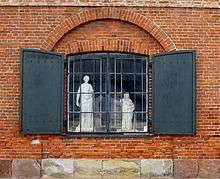
The Royal Cast Collection is held at the West India Warehouse, Toldbodgade 40, between The Little Mermaid and Nyhavn in Copenhagen. It consists of over 2,000 naked plaster casts of statues and reliefs from collections, museums, temples, churches, and public places throughout the world, from antiquity to the Renaissance. The Royal Cast Collection is only open for special events. The art was first put on display in 1895 with the intention of edifying visitors about the progression of representations of the human form over time in parallel with growing social, political and aesthetic awareness in the Western world.[12]
At the start of the Second World War the art of antiquity became increasingly unfashionable, associated with an archaic artistic tradition. In 1966, as abstract art became more popular, the Royal Cast Collection was removed to a barn outside Copenhagen for storage and only revived in 1984 when it was removed to the West India Warehouse.[13]
History
The collections of the Danish National Gallery originate in the Art Chamber (Danish: Kunstkammeret) of the Danish monarchs. When the German Gerhard Morell became Keeper of Frederick V's Art Chamber about 1750, he suggested that the king create a separate collection of paintings. To ensure that the collection was not inferior to those of other European royal houses and local counts, the king made large-scale purchases of Italian, Netherlandish and German paintings. The collection became particularly well provided with Flemish and Dutch art. The most important purchase during Morell's term as keeper was Christ as the Suffering Redeemer by Andrea Mantegna. 'Det Kongelige Billedgalleri' (Royal Art Gallery) was housed in Christiansborg Palace until 1884 when the castle burnt down.[14] It was not until the opening of the museum in 1896 that the art had a new home.[15]
Since then a great variety of purchases have been made. During the 19th century the works were almost exclusively by Danish artists, and for this reason the Museum has an unrivalled collection of paintings from the so-called Danish Golden Age. That the country was able to produce pictures of high artistic quality was something new, and a consequence of the establishment of the Royal Danish Academy of Fine Arts in 1754.
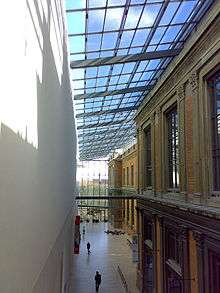
More recently, the collection has been influenced by generous donations and long-term loans. In 1928 Johannes Rump's large collection of early French Modernist paintings was donated to the Museum. This was followed by purchases of paintings and sculpture in the French tradition.[16]
Architecture
The original museum building was designed by Vilhelm Dahlerup and G.E.W. Møller and built 1889–1896 in a Historicist Italian Renaissance revival style.[17]
Towards the back of the museum is a large modern extension designed by the architects Anna Maria Indrio and Mads Møller from Arkitektfirmaet C. F. Møller. The extension was erected in 1998 to house the extensive modern art collection. The two buildings are connected by a glass panelled 'Street of Sculptures' walkway and theatre which stretches the entire length of the museum and looks out onto the Østre Anlæg park.[18] Talks, concerts and installations are all held in this area.
Gallery
- Unknown Spanish artist, St. Michael and the Dragon
.jpg) Lucas Cranach the Elder (1472 – 1553), date unknown, Crucifixion (Kreuzigung)
Lucas Cranach the Elder (1472 – 1553), date unknown, Crucifixion (Kreuzigung).jpg) Saint Christopher, by Donato Bramante, 1490
Saint Christopher, by Donato Bramante, 1490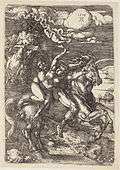 Abduction on a Unicorn, by Albrecht Dürer, 1516
Abduction on a Unicorn, by Albrecht Dürer, 1516).jpg)
_af_Sachsen's_jagt.jpg) The Stag Hunt of the Elector Frederic the Wise of Saxony, by Lucas Cranach the Elder, probably after 1529
The Stag Hunt of the Elector Frederic the Wise of Saxony, by Lucas Cranach the Elder, probably after 1529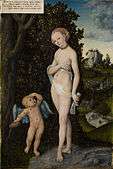 Venus and Cupid, the Honey Thief, by Lucas Cranach the Elder, 1530
Venus and Cupid, the Honey Thief, by Lucas Cranach the Elder, 1530.jpg) Lucas Cranach the Elder, 1532, Melancholie
Lucas Cranach the Elder, 1532, Melancholie- Lucas Cranach the Elder, 1532, Portrait of Martin Luther
- Marinus van Reymerswale, 1540, The moneychanger and his wife
 Pieter Aertsen, 1565-1575, The Fat Kitchen. An Allegory
Pieter Aertsen, 1565-1575, The Fat Kitchen. An Allegory Apollon and Diana punishing Niobe by Killing her Children, by Abraham Bloemaert, 1591
Apollon and Diana punishing Niobe by Killing her Children, by Abraham Bloemaert, 1591- Peter Brueghel the Younger, c.1605, The Way to Calvary
 Hendrick Goltzius, between 1573 and 1617, Cadmus slays the dragon
Hendrick Goltzius, between 1573 and 1617, Cadmus slays the dragon Bouquet of Flowers in a Stone Niche, Ambrosius Bosschaert, 1618
Bouquet of Flowers in a Stone Niche, Ambrosius Bosschaert, 1618 Bust of Camilla Barbadori, by Gian Lorenzo Bernini, 1619
Bust of Camilla Barbadori, by Gian Lorenzo Bernini, 1619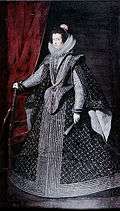 Diego Velázquez, c.1630, Isabel de Borbón
Diego Velázquez, c.1630, Isabel de Borbón The Annunciation, by Francesco Solimena (unknown date)
The Annunciation, by Francesco Solimena (unknown date) Cyclamen purpurascens; Cyclamen hederifolium, by Hans Simon Holtzbecker 1649-1659
Cyclamen purpurascens; Cyclamen hederifolium, by Hans Simon Holtzbecker 1649-1659 The Prodigal Son Living with Harlots, by Johann Wolfgang Baumgartner (unknown date)
The Prodigal Son Living with Harlots, by Johann Wolfgang Baumgartner (unknown date) Gerhard Morell, by Johann Salomon Wahl, 1765
Gerhard Morell, by Johann Salomon Wahl, 1765 The Wounded Philoctetes, by Nicolai Abraham Abildgaard, 1775
The Wounded Philoctetes, by Nicolai Abraham Abildgaard, 1775 Amor patriae. Allegory symbolising patriotism, by Carl Frederik Stanley, 1777
Amor patriae. Allegory symbolising patriotism, by Carl Frederik Stanley, 1777 The Russian ship of the line 'Assow' and a Frigate at Anchor in the Roads of Elsinore, Christoffer Wilhelm Eckersberg, 1828
The Russian ship of the line 'Assow' and a Frigate at Anchor in the Roads of Elsinore, Christoffer Wilhelm Eckersberg, 1828 Bretagne-pige ordner planter i et drivhus, by Anna Petersen, 1884
Bretagne-pige ordner planter i et drivhus, by Anna Petersen, 1884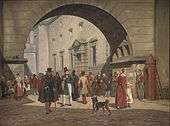 The Prison of Copenhagen, by Martinus Rørbye, 1831
The Prison of Copenhagen, by Martinus Rørbye, 1831- Ditlev Blunck, 1840–45, Youth, from the series The Four Ages of Man
 The Artist's Wife, Catherine Jensen, wearing a turban, Christian Albrecht Jensen, ca. 1842-4
The Artist's Wife, Catherine Jensen, wearing a turban, Christian Albrecht Jensen, ca. 1842-4 A Beech Wood in May near Iselingen Manor, Zealand, by Peter Christian Skovgaard, 1857
A Beech Wood in May near Iselingen Manor, Zealand, by Peter Christian Skovgaard, 1857- Harald Slott-Moller, 1891, Adam and Eve
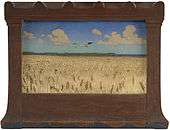 Danish Landscape, by Harald Slott-Møller, 1891
Danish Landscape, by Harald Slott-Møller, 1891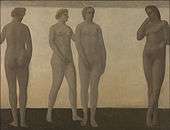 Artemis, by Vilhelm Hammershøi, 1893-4
Artemis, by Vilhelm Hammershøi, 1893-4 The Buildings of the Asiatic Company, seen from St. Annæ Street, by Vilhelm Hammershøi, 1902
The Buildings of the Asiatic Company, seen from St. Annæ Street, by Vilhelm Hammershøi, 1902.jpg) Henri Matisse, 1906, Self-Portrait in a Striped T-shirt
Henri Matisse, 1906, Self-Portrait in a Striped T-shirt
 Amedeo Modigliani, 1915, Alice
Amedeo Modigliani, 1915, Alice
References
- ↑ (in Danish) Attraktionsstatistikken 2007 - top50. 2008-04-25.
- ↑ Bergløv, Emil. "På guidet tur med direktøren: Mikkel Bogh græder ikke over god kunst". Politiken. Retrieved 12 January 2015.
- ↑ "Visiting Information". SMK. Statens Museum for Kunst.
- ↑ "SMK Open". National Gallery of Denmark.
- ↑ Pedersen, Eva de la Fluente; Rung, Mette Houlberg; Bernhardt, Nana. "European Art 1300-1800: About the Collection". SMK. Statens Museum for Kunst. Retrieved 6 January 2015.
- ↑ Holm, Henrik; Monrad, Kasper. "Danish and Nordic Art 1750 - 1900: About the Display". SMK. Statens Museum for Kunst. Retrieved 6 January 2015.
- ↑ Aagesen, Dorthe; Houlberg Rung, Mette. "French Art 1900 - 1930: Rump, Matisse and the French Collection". SMK. Statens Museum for Kunst. Retrieved 6 January 2015.
- ↑ Torp, Marianne; Dorthe, Aagesen; Larsen, Berit Anne. "Danish and International Art After 1900: About the Display". SMK. Statens Museum for Kunst. Retrieved 6 January 2015.
- ↑ Holm, Henrik. "About the collection of Graphic Art". SMK. Statens Museum for Kunst. Retrieved 7 January 2015.
- ↑ Holm, Henrik. "About the collection of Graphic Art". SMK. Statens Museum for Kunst. Retrieved 7 January 2015.
- ↑ Holm, Henrik. "About the collection of Graphic Art". SMK. Statens Museum for Kunst. Retrieved 7 January 2015.
- ↑ Holm, Henrik; Fridriksdottir, Ayoe. "The Royal Cast Collection: The History of the Cast Collection". SMK. Statens Museum for Kunst. Retrieved 6 January 2015.
- ↑ Holm, Henrik; Fridriksdottir, Ayoe. "The Royal Cast Collection: The History of the Cast Collection". SMK. Statens Museum for Kunst. Retrieved 6 January 2015.
- ↑ Villadsen, Villads (1998). Statens Museum for Kunst 1827 - 1952. Gyldendal. p. 13. ISBN 87-00-34756-6.
- ↑ Villadsen, Villads (1998). Statens Museum for Kunst 1827 - 1952. Gyldendal. p. 100. ISBN 87-00-34756-6.
- ↑ Top, Marianne; Aagesen, Dorthe; Larsen, Berhit Anne. "Danish and International art after 1900". SMK. Statens Museum for Kunst.
- ↑ Villadsen, Villads (1998). Statens Museum for Kunst 1827 - 1952. Gyldendal. p. 99. ISBN 87-00-34756-6.
- ↑ "National Gallery of Denmark - Extension". C. F Møller.
External links
| Wikimedia Commons has media related to Statens Museum for Kunst. |
Coordinates: 55°41′20″N 12°34′43″E / 55.68889°N 12.57861°E
